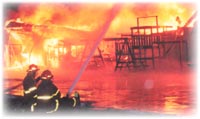
Do you know your HAZMATs?

Do you know your HAZMATs?
 Define
the following terms:
Define
the following terms:
HazMat, MSDS, Molecular Weight,
Specific Gravity, Boiling Point,
Flash Point, Vapor Pressure,
UFL, LFL, IDLH.
The term HazMat means Hazardous Materials, and
they are all around us. We use them for fueling our vehicles, cooking and
heating, maintaining lawns and gardens, and keeping pests out of the house.
However, we may pay little attention to their associated risks-- fire,
explosion, poisoning, asphyxiation, and others. The combined rapid technological
advances during the 20th century, leading to disasters of epic proportions
and many more smaller ones, increased environmental awareness and caused
society to develop an elaborate framework of regulations and technical
tools to enable us to manage hazardous materials safely. Mathematical modeling
is key to many of these developments in an unusually wide variety of ways.
In particular a number of risk analysis computer programs were developed
and are employed by a growing number of agencies in an attempt to both
minimize damaging consequences in case of HazMat accidents, and also to
minimize the number of such accidents through advanced planing.
Meet![]() ARCHIE your interactive, user friendly HazMat program as it helps
the HazMat unit of Hartford's Fire Department make a crucial decision while
on a HazMat accident scene:
ARCHIE your interactive, user friendly HazMat program as it helps
the HazMat unit of Hartford's Fire Department make a crucial decision while
on a HazMat accident scene:
A westbound gasoline tank truck overturns on Interstate
I-91, and its cargo of 7,000 gallons spills out almost immediately and
collects in a pool in a depression just off the right shoulder of the road.
This pool of gasoline is roughly circular and has a diameter of 20 feet,
and it is located off the side of the westbound lanes, about 25 feet at
its nearest point from the westbound roadway and 150 feet from the eastbound
lanes. There is a slight wind blowing from the north at 4 mph., and it
is very sunny. YOU ARE THE LOCAL FIRE CHIEF, and you arrive on the
scene within 10 minutes of the accident. Your first decision has to do
with whether to close down the eastbound side of the road for fear of ignition
of the vapors from the evaporating pool by a passing car. It is a hot day,
80 degrees F , and the smell of gasoline is very strong. Is this a significant
hazard?
You ask your HazMat unit, which has just arrived on the
scene, to perform a case scenario analysis. ![]() ARCHIE
is installed on their state of the art computer in their HazMat truck.
They immediately log on and start a dialog with
ARCHIE
is installed on their state of the art computer in their HazMat truck.
They immediately log on and start a dialog with ![]() ARCHIE
inputting data from the MSDS, Material Safety Data Sheet, of the chemical
mixture called gasoline, the weather and atmospheric conditions, and the
geographic parameters of the accident.
ARCHIE
inputting data from the MSDS, Material Safety Data Sheet, of the chemical
mixture called gasoline, the weather and atmospheric conditions, and the
geographic parameters of the accident.
After just a moment consideration![]() ARCHIE tells them that the downwind distance to a concentration
of 1/2 LFL is 66 feet. The model treats the actual release as a point release,
using the area of the pool to determine evaporation rate. However, this
66 foot distance should be treated as from the downwind edge of the pool,
as any other approach is non conservative. This is considerable less than
the distance to the eastbound lanes, so closing of those lanes would not
be strictly necessary.
ARCHIE tells them that the downwind distance to a concentration
of 1/2 LFL is 66 feet. The model treats the actual release as a point release,
using the area of the pool to determine evaporation rate. However, this
66 foot distance should be treated as from the downwind edge of the pool,
as any other approach is non conservative. This is considerable less than
the distance to the eastbound lanes, so closing of those lanes would not
be strictly necessary.
Your fire fighters can now concentrate on spraying foam on the surface to reduce the rate of evaporation, without the additional complication of handling the closing of the eastbound lanes. As they finish the foam spraying, a temporary solution, the Clean-Up Contractor's tank truck arrives and is getting ready to pump the spilled gasoline into his tank.
Handling this accident was accomplished efficiently and
without casualties. You may yet be home early enough to eat dinner with
your family.
Thanks ![]() ARCHIE,
you are a pal!
ARCHIE,
you are a pal!